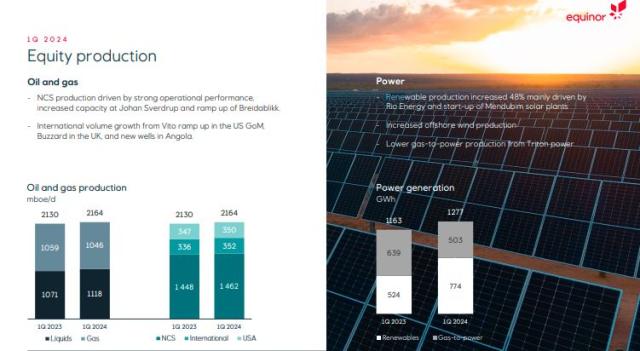Equinor, Norway’s prominent oil and gas producer, has reported operating income of $7.63 billion and net income of $2.67 billion during the first quarter of 2024.
“Equinor delivered solid financial results driven by strong operational performance across the business. Production on the Norwegian continental shelf was high, and the international portfolio contributed with solid production growth,” Anders Opedal, President and CEO of Equinor, said in its earnings report.
Equinor achieved production of 2,164 mboe per day in the first quarter, up from 2,130 mboe per day in the same quarter last year, driven by strong operational performance. Equinor said increased capacity at Johan Sverdrup and ramp up of Breidablikk, in addition to new wells on stream, contributed to increased growth on the Norwegian continental shelf. The Vito field in the US Gulf of Mexico and the Buzzard field in the UK, in addition to new wells in Angola contributed to 3 percent production growth internationally.
Equinor’s renewable production
Equinor’s renewable production rose 48 percent to 774 GWh in the first-quarter mainly driven by Rio Energy and start-up of Mendubim solar plants. The growth came primarily from onshore power plants in Brazil, in which Rio Energy was the key contributor. Higher production from the offshore windfarms also supported the increased power production.
Equinor enhanced offshore wind production. Renewables assets contributed $46 million in adjusted operating income. It aims at doubling renewable power generation during 2024. Equinor does not reveal the revenue from its renewable energy business.
“We maintain a value-driven approach to renewables growth. In the quarter, we achieved significantly better terms for our Empire Wind 1 project in the US and started the commercial production from the Mendubim solar plants in Brazil,” Anders Opedal said.
Strategic progress
The activity level on the NCS was high. The plan for development of the Eirin field, a subsea tieback to Gina Krog, was approved and the field is expected to contribute with gas volumes from next year. In April, Equinor announced the start-up of electrification of the Sleipner field centre, along with the Gudrun platform and other associated fields, which is expected to further reduce emissions from the operations.
Equinor has optimised its oil and gas portfolio with the swap transaction in the US onshore business, exiting the operated position in Ohio and increasing its position in partner-operated assets in Northern Marcellus in Pennsylvania. Equinor will pay a cash of $500 million to balance the overall transaction.
In the quarter, Equinor completed nine exploration wells offshore with two commercial discoveries. Three wells were ongoing at the quarter end. The company was awarded 39 new production licenses on the NCS.
Equinor secured a significantly improved offtake price for its Empire Wind 1 project on the US East Coast. Planned next steps include final investment decision, project financing and farm down to a new partner. In Brazil, production started at the 531 MW Mendubim solar plants, where Equinor has a 30 percent ownership share.
Equinor has surpassed Russia’s Gazprom as Europe’s largest natural gas supplier in 2022, following geopolitical tensions stemming from Moscow’s invasion of Ukraine, Reuters news report said.
The decline in natural gas prices was evident in Europe’s benchmark, the Dutch TTF front-month gas contract, which averaged 27.51 euros per megawatt hour (MWh) in the first quarter, down from 52.73 euros/MWh a year earlier due to a mild winter and ample storage.
Equinor maintained its oil and gas output projection for the year, expecting it to remain flat compared to 2023. The company’s international oil and gas production saw a 3 percent increase from the previous year, buoyed by acquisitions and a rise in domestic production.
Baburajan Kizhakedath

